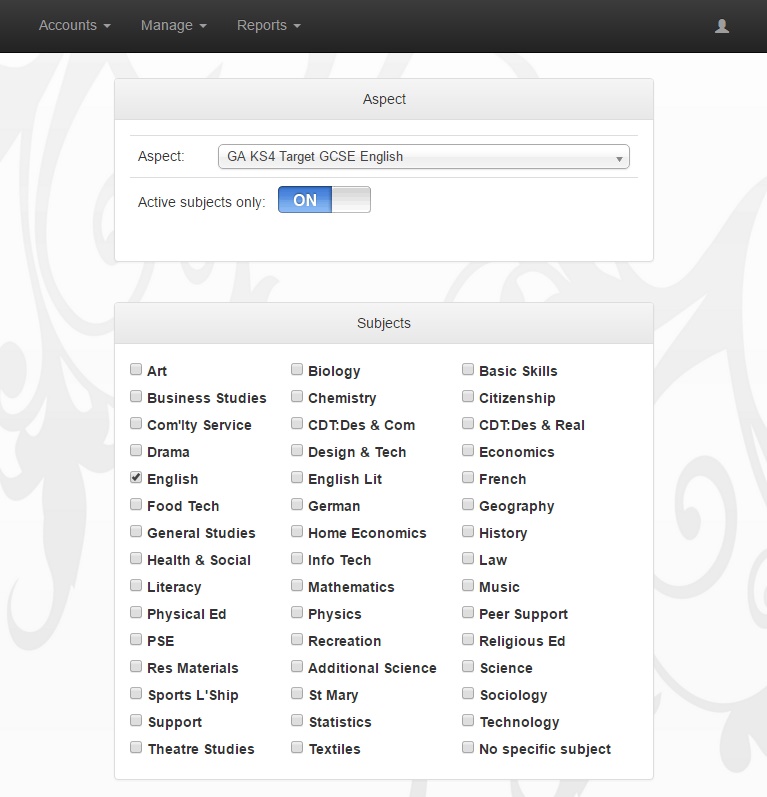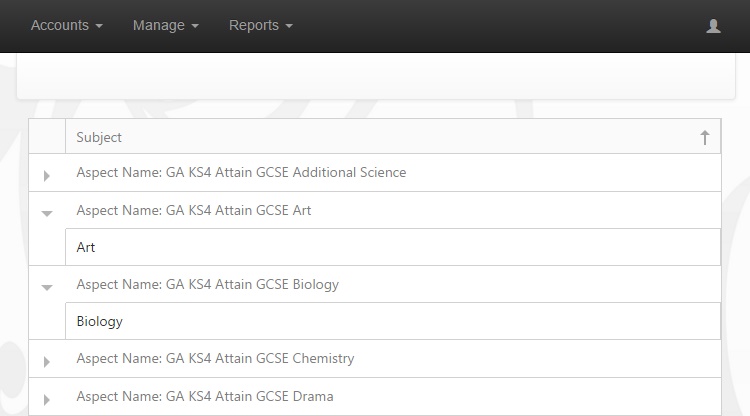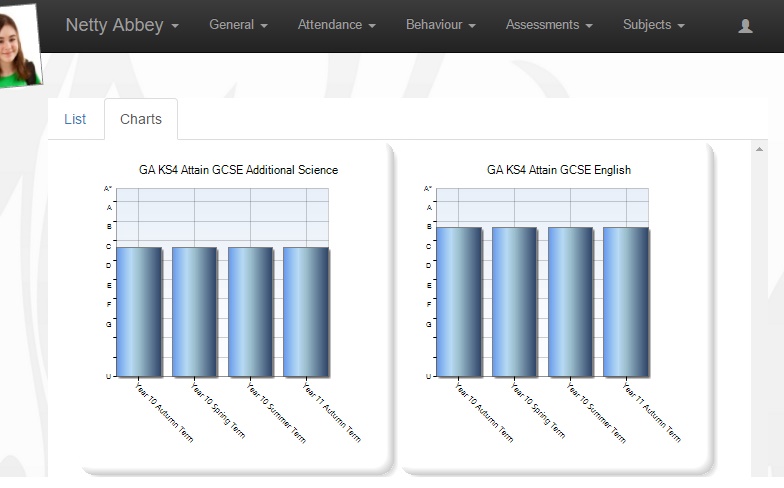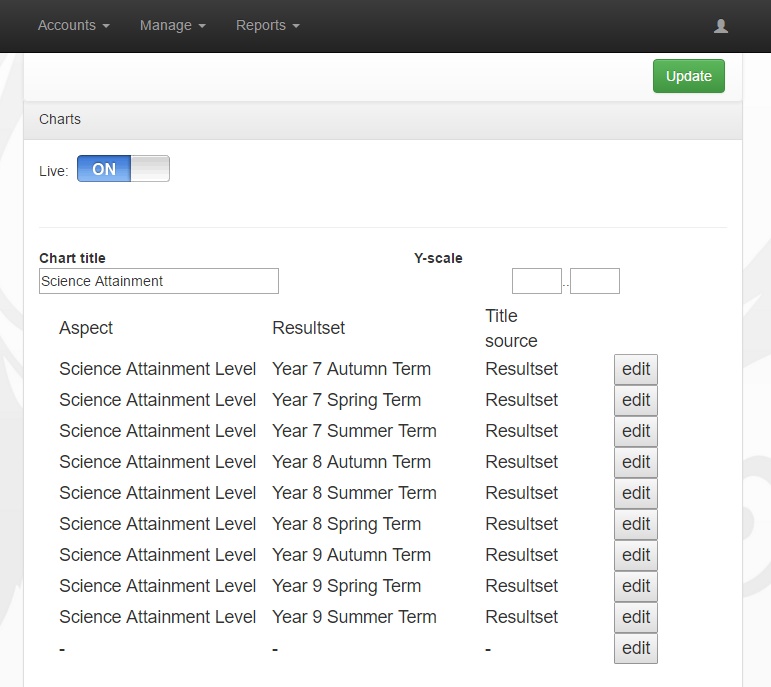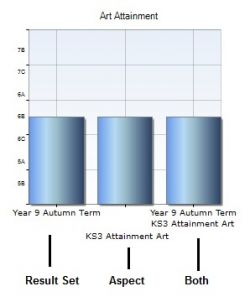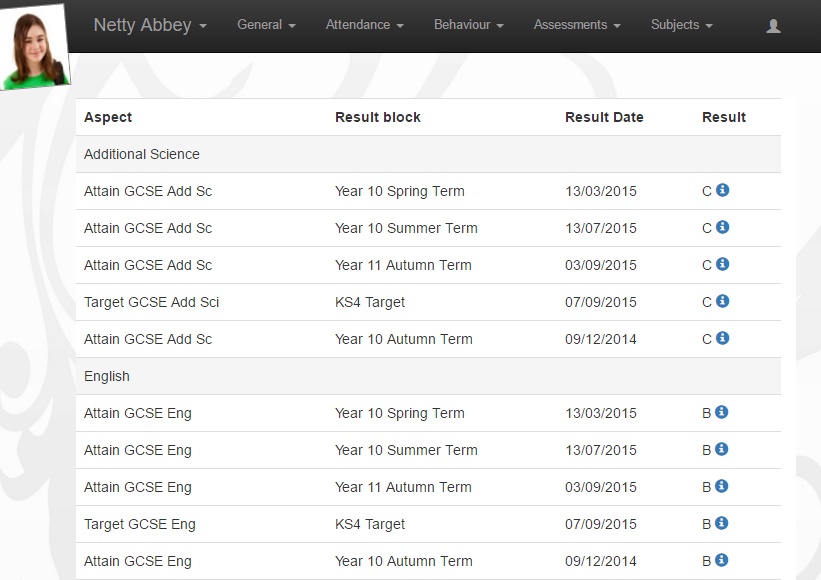Test
Contents
Setup
Importing Grades from SIMS
The AM Subjects page is used to pull grading aspects from SIMS into Insight, so that grades can be seen by parents and pupils. AM stands for Assessment Manager. If you are using PARS and have created SIMS elements in PARS, then you do not need to use the AM Subjects page - instead you can pull elements into Insight via the preferences page.
The AM Subjects page
The page will show two dropdown menus at the top which are used to select SIMS aspects. Once an aspect have been selected, a table will appear at the bottom displaying the subjects as taken from your timetable.
Adding aspects
First select the aspect you want to pull into Insight in the Aspect dropdown at the top of the page. Once you have clicked the dropdown you can use the text field to search for aspects by their name. It is not recommended that you use the Target dropdown menu.
Once you have selected the aspect you will see a list of subjects appear at the bottom of the page. An aspect is pulled into Insight when it is linked to one or more subjects so select the relevant subjects for the Aspect you have chosen. There is no save button; all you need to do is tick the subjects.
Reviewing linked aspects
To see a list of the aspects that have already been configured you will need to leave the AM Subjects page. A report showing all of the linked aspects can be found via:
Reports > Linked aspects
Importing Grades from PARS
Configuring Charts
The AM charts page is used to configure bar charts that appear on the assessments page (users will need the "Show progress charts" role option enabled to see the charts). The charts can either be configured via the AM charts page, or by editing a text file on the IIS server that hosts Insight.
In order for charts to be displayed, grades must be collected from SIMS rather than PARS. The setting for this is found via Preferences > PARS > Collect grades from PARS (this is only applicable to schools using PARS).
Charts can either be created by using the AM charts page in Insight, or by editing a text file on the IIS server hosting Insight.
Using the AM charts page
At the top of the page there is a "Live" option. This must be switched on in order for charts to be displayed to users. The rest of the page is used to configure the charts.
Each chart needs to be given a title. There is an edit button which opens a window to add a column to the chart. In the window there are options to select an Aspect and Result Set, from which the data will be taken. There is also a "Column title source" option used to label the column, which can be set to either Aspect, Result Set or Both.
Each chart will need one or more columns added to it in order for it to be displayed to users. Multiple charts can be created and will look similar to the following:
Using the text file on the IIS server
There is a file on the server that hosts Insight which can be used to create the AM charts. The file is found in the _Personalisation folder, which is typically C:\wwwroot\inetput\INSIGHT\_Personalisation. The file will either be called assessments.charts or assessments.charts.unused
If you have a file called assessments.charts then open that file using Notepad or a similar basic text editor (not Microsoft Word!). If you do not have an assessment.charts file but do have an assessments.charts.unused file, then edit the assessments.chart.unused file, remove the .unused extension, then edit the file using Notepad or similar basic text editor. If you do not have either file, run an Insight service pack.
The first line of the file must always read:
<root>
Following that, a new chart can be created by adding the following line of text:
<chart id="ENTER TITLE HERE" />
Where ENTER TITLE HERE is replaced by the title for the chart.
Columns are then added using the following line of text, repeated for each column on the chart:
<aspect chart="ENTER TITLE HERE" aspect="ENTER ASPECT NAME" resultset="ENTER RESULT SET NAME" xlabel="ENTER LABEL" />
The name of the chart, the Aspect and the Result Set must be entered into the relevant sections. If the aspect is not associated with a Result Set, no text should be entered into the resultset option. The xlabel option can be set to:
a - for the name of the Aspect
r - for the name of the Result Set
ra - for the name of the Aspect and Result Set
The lines above can be repeated to create multiple charts and columns. The final line of text must read:
</root>
This example represents a chart showing nine samples of a single aspect over Key Stage 3:
<chart id="KS3 Science Level" /> <aspect chart="KS3 Science Level" aspect="Science Attainment Level" resultset="Year 7 Autumn Term" xlabel="r" /> <aspect chart="KS3 Science Level" aspect="Science Attainment Level" resultset="Year 7 Spring Term" xlabel="r"/> <aspect chart="KS3 Science Level" aspect="Science Attainment Level" resultset="Year 7 Summer Term" xlabel="r"/> <aspect chart="KS3 Science Level" aspect="Science Attainment Level" resultset="Year 8 Autumn Term" xlabel="r"/> <aspect chart="KS3 Science Level" aspect="Science Attainment Level" resultset="Year 8 Summer Term" xlabel="r"/> <aspect chart="KS3 Science Level" aspect="Science Attainment Level" resultset="Year 8 Spring Term" xlabel="r"/> <aspect chart="KS3 Science Level" aspect="Science Attainment Level" resultset="Year 9 Autumn Term" xlabel="r"/> <aspect chart="KS3 Science Level" aspect="Science Attainment Level" resultset="Year 9 Spring Term" xlabel="r"/> <aspect chart="KS3 Science Level" aspect="Science Attainment Level" resultset="Year 9 Summer Term" xlabel="r"/>
This example shows different Aspects sampled from the same Result Set:
<chart id="GCSE Targets" /> <aspect chart="GCSE Targets" aspect="GCSE Art Target" resultset="Year 10 Target" xlabel="a"/> <aspect chart="GCSE Targets" aspect="GCSE Biology Target" resultset="Year 10 Target" xlabel="a"/> <aspect chart="GCSE Targets" aspect="GCSE Chemistry Target" resultset="Year 10 Target" xlabel="a"/> <aspect chart="GCSE Targets" aspect="GCSE Computing Target" resultset="Year 10 Target" xlabel="a"/> <aspect chart="GCSE Targets" aspect="GCSE Dance Target" resultset="Year 10 Target" xlabel="a"/> <aspect chart="GCSE Targets" aspect="GCSE Drama Target" resultset="Year 10 Target" xlabel="a"/> <aspect chart="GCSE Targets" aspect="GCSE English Target" resultset="Year 10 Target" xlabel="a"/>
Advanced Configuration
The files in the _Personalisation folder allow you to make specific changes to Insight which cannot be put in place through either the role options or preference settings.
All the files will initially have an extension of '.unused'; in addition to any actions below you will need to remove the 'unused' extension for the file(s) to take effects.
aspect.priorities
This folder allows you to make amendments to the priority of Aspects and the priority of the Subject and Year Group within the Aspect.
In order for this to work the settings for the role must be set correctly. Within subjects ensure the setting for 'use_Personalisation\aspect.priorities file' is set to 'on'.
blacklisted.aspect.resultsets
There may be specific aspect and resultset combinations that you never want to display in Insight. In the file you will need one line for each aspect/resultset combination that you want to blacklist. The name of the aspect should appear first, then a comma, then the name of the result set. For example:
End of Year Grade, Preliminary results
Parent and Student View
The assessments page shows a list of grades taken from SIMS aspect or PARS elements. The aspects/elements shown are chosen via the AM subjects or preferences page, respectively.
Options to Configure
- For these years
- Enter a list of year groups, separated by the plus symbol, for which this menu item is to be shown.
- Show data from how many previous academic years
- Select the number of years of data you want the user to see.
- or specify other amounts for specific yeargroups
- Enter amounts in the form yeargroup:amount, separated by a plus, for example 7:0+8:1+9:2+10:0+11:1+12:0+13:1
- Alternative menu title
- Enter a word to use in menus in place of Assessments.
- Earliest
- Assessment data entered before this date will not be shown
- Latest
- Assessment data entered after this date will not be shown
- Latest first
- Turn this option on to attempt to order the assessments with the most recent at the top.
- Limit to current subjects
- Turn this option on to only show assessments for currently taken subjects, or leave switched off for all subjects
- Use column headings in place of aspect name
- The aspect's column heading will be displayed, rather than the aspect name itself
- Use gradeset description in place of result
- Where a result has a description within its gradeset, use this instead of the actual result.
- Expand by default
- This options sets whether groups of assessments start out expanded or collapsed.
- Show result block
- To show assessments by resultset or reporting period.
- group by result block
- Use this option to cluster assessments by resultset or reporting period.
- Limit Targets to main grade result block
- Limit to main grade result block
- Attempt level split on aspect name
- Useful only if your aspect names begin with a recognisable level, results can be arranged in levels.
- Show grade help popup
- Will provide help popup regarding grades.
- Show progress charts
- Hide or show progress charts
- Hide comments where a result exists
- Just show grade not comment
